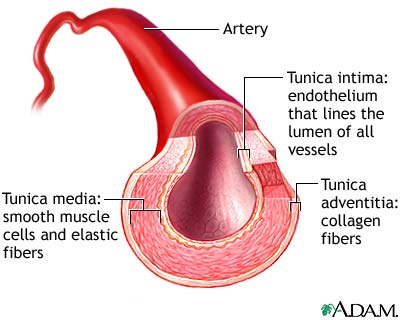Artery - definition and function

Artery is a flexible, muscular BLOOD vessel that carries blood from the HEART and oxygenated blood to tissues throughout the body. The wall of an artery has three layers:
- adventitia, the outermost layer, which is primarily connective tissue that gives the artery its FLEXIBILITY
- media, the middle layer, which is mostly smooth MUSCLE tissue that gives the artery the ability to contract and relax
- intima, the inner layer, which is epithelial tissue that provides a smooth surface to facilitate the flow of blood
The adventitia is more prominent in larger arteries such as the AORTA and the carotid arteries, encasing the artery in a weblike fashion without clear direction to its fibers. In smaller arteries, the media often dominates the artery’s structure. The muscle fibers of the media encircle the artery, helping strengthen and stabilize the artery’s walls. The delicate intima contains two structural levels, the basement or foundation membrane and the subepithelial layer, both of which run lengthwise. Each may be only a cell’s thickness in small arteries, indistinguishable without magnification.
The intima’s two-level structure gives the artery its ability to carry blood cells without having them stick to its inner walls. However, it also makes the artery vulnerable to ATHEROSCLEROSIS, which develops between the intima’s two levels. The tiniest of the body’s arteries, about the thickness of a hair, are arterioles. The body’s largest artery is the aorta, which carries blood from the heart to the network of arteries that then carry the blood throughout the body.
Fibrous sheaths enclose most of the body’s arteries, usually along with the companion VEIN and NERVE. These sheaths often parallel skeletal structures for protection and stability, or run deep within the body. Arteries also receive blood themselves from other arteries, which deliver oxygen and other nutrients to the layers of the artery, and contain nerves that deliver the signals to constrict or dilate. The walls of the arteries constrict and dilate in wavelike contractions that coordinate with the heartbeat to help push blood through the body. These pulsations are detectable as the PULSE at points where the artery is near the surface of the skin, such as at the wrist and the groin.
For further discussion of the artery within the context of cardiovascular structure and function, please see the overview section “The Cardiovascular System.”
See also ARTERIOVENOUS MALFORMATION (AVM); ATHEROSCLEROSIS; ARTERIOSLCEROSIS; CAROTID BRUIT; CAROTID STENOSIS; CORONARY ARTERY DISEASE (CAD).
Open discussion on the topic The Artery - definition and function
Similar interests
- Nuovi Casino
- Casinos Not On Gamstop
- UK Casinos Not On Gamstop
- Casinos Not On Gamstop
- UK Casinos Not On Gamstop
- Casino Non Aams Italia
- Slot Sites Not On Gamstop
- Meilleur Casino En Ligne
- Non Gamstop Casino Sites UK
- Meilleur Casino En Ligne
- Casino En Ligne France
- Best Non Gamstop Casinos
- Casinos Not On Gamstop
- UK Casino Not On Gamstop
- Casinos Not Signed Up To Gamstop
- Best Slot Sites UK
- Non Gamstop Casino Sites UK
- Online Casinos Nederland
- Online Casinos Nederland
- Casinos Not On Gamstop
- Best New Uk Casinos Not On Gamstop